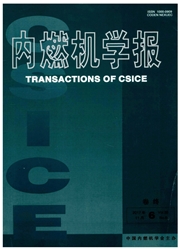

 中文摘要:
中文摘要:
通过改变进气压力,研究了不同EGR率下的燃烧和排放特性.结果表明,除了温度和压力之外,过量空气系数对滞燃期也有较大的影响.随进气压力变大,Soot峰值升高,对应的EGR率也增大,在相同的Soot排放时,可以选择更大的EGR率以进一步降低NOx排放.虽然低温燃烧解决了NOz和Soot之间的Trade-Off,但产生了燃油经济性、CO和THC排放与Soot之间的Trade—Off.对整个EGR率进行了分区,通过中等EGR率和高EGR率性能和排放对比,从工程应用角度来看,对Soot-Bump之前的中等EGR率低温燃烧区域进行燃烧优化将是满足未来排放法规的重点.
 英文摘要:
英文摘要:
The combustion and emission characteristics at different EGR rates are investigated by chang- ing the intake pressure. Results show that excess air coefficient greatly affects the ignition delay besides temperature and pressure. With increasing the intake pressure, the peak of soot and corresponding EGR rate increase. Under the same level of soot emissions, higher EGR rate should be used to further decrease NOx emissions. Although a Trade-off between NOx and soot does not exists, the Trade-Off between fuel economy, CO, THC and soot occurs. EGR region is divided. Comparison of performance and emission characteristics at medium EGR and high EGR suggests that an optimized combustion at medium EGR be- fore Soot-Bump is the key approach to meet ever stringent emission regulations.
 同期刊论文项目
同期刊论文项目
 同项目期刊论文
同项目期刊论文
 Investigation of the combustion characteristics and the emissions characteristics with diesel low-te
Investigation of the combustion characteristics and the emissions characteristics with diesel low-te The Design and Optimized Combination of Combustion Modesover Full-Load Range in a Multi-cylinder Lig
The Design and Optimized Combination of Combustion Modesover Full-Load Range in a Multi-cylinder Lig Development of an n-heptane-n-butanol-PAH mechanism and its application for combustion and soot pred
Development of an n-heptane-n-butanol-PAH mechanism and its application for combustion and soot pred Study of the control strategies on soot reduction under early-injection conditions on a diesel engin
Study of the control strategies on soot reduction under early-injection conditions on a diesel engin Experimental study on combustion and emission characteristics of a diesel engine fueled with 2,5-dim
Experimental study on combustion and emission characteristics of a diesel engine fueled with 2,5-dim A semi-detailed chemical kinetic model of a gasoline surrogate fuel for internal combustion engine a
A semi-detailed chemical kinetic model of a gasoline surrogate fuel for internal combustion engine a Experimental and numerical study on different dual-fuel combustion modes fuelled with gasoline and d
Experimental and numerical study on different dual-fuel combustion modes fuelled with gasoline and d Development of an n-heptane/toluene/polyaromatic hydrocarbon mechanism and its application for combu
Development of an n-heptane/toluene/polyaromatic hydrocarbon mechanism and its application for combu Combustion and emissions of 2,5-dimethylfuran addition on a diesel engine with low temperature combu
Combustion and emissions of 2,5-dimethylfuran addition on a diesel engine with low temperature combu 期刊信息
期刊信息
